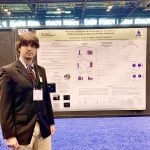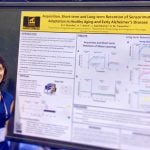Dr. Kevin Trewartha, Director of the Aging, Cognition, and Action Lab, accompanied by two of his current PhD candidates, Bridget Durocher and Isaac Flint, attended the Society for Neuroscience convention to present their research. This year represented the 50th annual convention, and it was held in Chicago, IL. This convention is one of the largest international conventions for the study of neuroscience with speakers and exhibitors from all around the world. Opportunities to meet Nobel Prize winner in Physiology or Medicine in 2000 Eric Kandel for his work on signal transduction in the nervous system, global industry leaders in neuroscience technology, and leaders on the forefront of brain research were all part of this year’s experience.
Bridget Durocher presented preliminary findings of her research investigating whether acquisition, and short- and long-term retention measures of motor learning can distinguish between amnestic mild cognitive impairment (MCI), Alzehimer’s disease (AD), and healthy aging. The ultimate goal of this work is to potentially supplement existing neuropsychological measures for diagnosing AD. The need for additional or new techniques to diagnose AD in its earliest stages is essential in extending the quality of life for our future generations. The current standard testing procedures often miss the early onset phase of the disease process, leading many years of missed opportunities to manage the disease effectively. In the current project we are investigating whether the early stages of motor learning are affected by MCI and early AD, and whether those patients exhibit additional impairments in short-term (i.e., within session) and long-term (after a 24-hour delay) retention of a newly acquired motor skill. Initial results are encouraging, and support our hypothesis, but it should be stressed that these data are very preliminary.
Isaac Flint presented findings from work investigating whether younger and older adults differ in the ability to make optimal corrective actions for collision avoidance during reaching movements. This work showed that when making motor corrections in response to visual feedback perturbations, both older and younger adults are equally able to make optimal decisions when correcting their movements to avoid collisions with obstacles. However, older adults make less efficient movements indicated by longer movement times, exhibit increased rates of collision, and delayed electrophysiological responses to the visual feedback perturbations. The efficiency with which older adults made corrective actions was also correlated with cognitive measures of executive control, and processing speed.
In addition to attending the conference Bridget and Isaac took some time to explore the city, learning to navigate Chicago’s public transportation, and visiting various spots including the Harold Washington Library Center of the Chicago Public Library, Little Italy, Millennium Park, downtown shops, and the lakefront. Having a diverse population to network with along with the unique cultural opportunities Chicago has to offer made this convention an excellent opportunity to explore both cognitive neuroscience and human factors.

